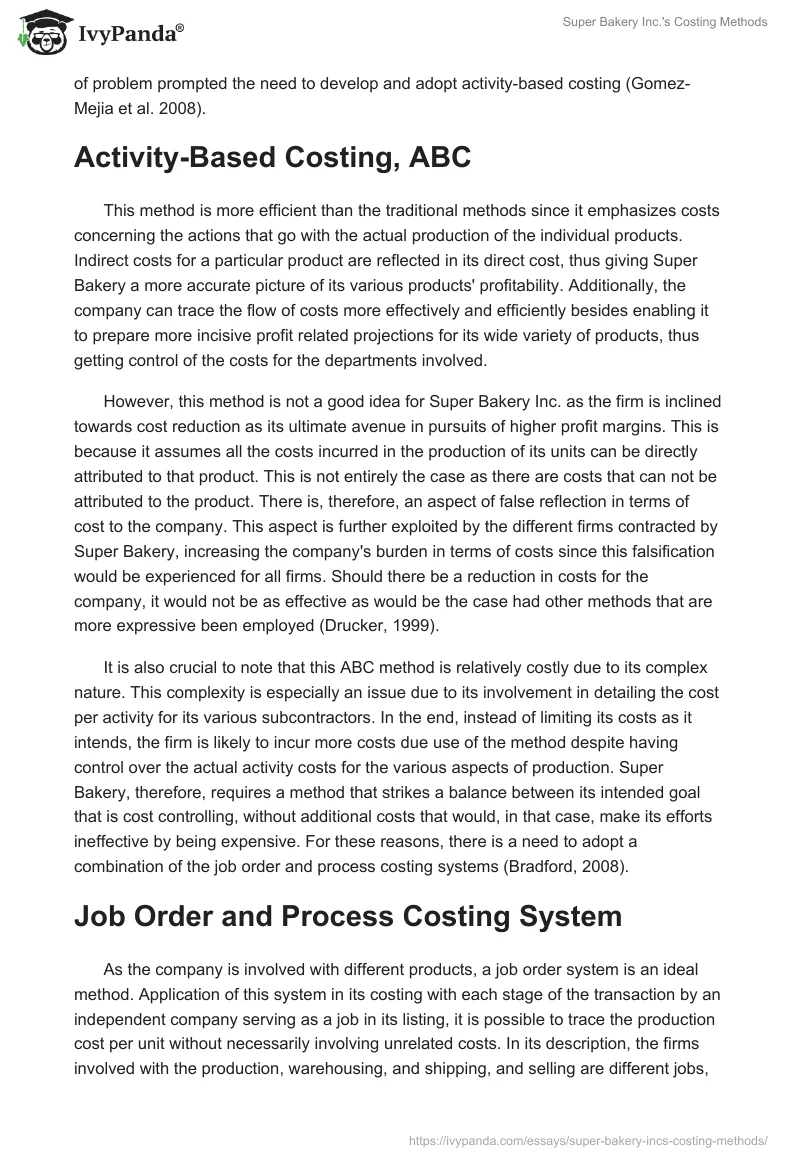Strategies Used by Super Bakery Inc.
Super Bakery Inc. was a virtual corporation preferring to outsource its main business applications. This was with a view of minimizing the cost of operation relative to its income levels. By outsourcing, Super Bakery was able to control the flow of the activities that yielded its revenue. This was without necessarily taking the immense responsibility of bearing the risks involved with each stage of production and transaction. This explains the realization of its goal in the reduction of expenses. Otherwise, it would incur the expenses through the acquisition of relevant assets for the various processes involved.
These processes include machinery for the production of the different products, maintenance of these machines, and their replacement whenever that need came up, and the costs of production. Examples of costs of production include the cost of raw materials and other inputs as well as overhead costs such as the cost of electricity, water, salaries, and wages for the greater number of employees that would have to be directly and indirectly involved in the process (Staubus, 1971). Costs of transportation of inputs and finished products to the various distribution points are also eliminated, as are the costs of storage of raw materials and finished products before transportation to the target market (Horngren and Foster, 2003).
Super Bakery employed the traditional costing methods, which relied on the listing of the costs for the various businesses it had sought to perform the various responsibilities on its behalf. This involved the write-down of the individual company’s schedule for all firms so that their individual costs and revenues were not independent of Super Bakery’s costs schedule. This meant that the final cost per product was spread out evenly in its units of merchandise. Therefore, it was not possible to maximize on the highly profitable units due to their relatively low costs since the low-profit margin units whose production costs were high had a neutralizing effect on them. In perspective, the variation in the cost per unit structure is superficially hidden by the unification. It, therefore, makes it impossible to tell the costs per unit for individual lines of product. This explains the difficulty in controlling the individual line of production costs. This kind of problem prompted the need to develop and adopt activity-based costing (Gomez-Mejia et al. 2008).
Activity-Based Costing, ABC
This method is more efficient than the traditional methods since it emphasizes costs concerning the actions that go with the actual production of the individual products. Indirect costs for a particular product are reflected in its direct cost, thus giving Super Bakery a more accurate picture of its various products’ profitability. Additionally, the company can trace the flow of costs more effectively and efficiently besides enabling it to prepare more incisive profit related projections for its wide variety of products, thus getting control of the costs for the departments involved.
However, this method is not a good idea for Super Bakery Inc. as the firm is inclined towards cost reduction as its ultimate avenue in pursuits of higher profit margins. This is because it assumes all the costs incurred in the production of its units can be directly attributed to that product. This is not entirely the case as there are costs that can not be attributed to the product. There is, therefore, an aspect of false reflection in terms of cost to the company. This aspect is further exploited by the different firms contracted by Super Bakery, increasing the company’s burden in terms of costs since this falsification would be experienced for all firms. Should there be a reduction in costs for the company, it would not be as effective as would be the case had other methods that are more expressive been employed (Drucker, 1999).
It is also crucial to note that this ABC method is relatively costly due to its complex nature. This complexity is especially an issue due to its involvement in detailing the cost per activity for its various subcontractors. In the end, instead of limiting its costs as it intends, the firm is likely to incur more costs due use of the method despite having control over the actual activity costs for the various aspects of production. Super Bakery, therefore, requires a method that strikes a balance between its intended goal that is cost controlling, without additional costs that would, in that case, make its efforts ineffective by being expensive. For these reasons, there is a need to adopt a combination of the job order and process costing systems (Bradford, 2008).
Job Order and Process Costing System
As the company is involved with different products, a job order system is an ideal method. Application of this system in its costing with each stage of the transaction by an independent company serving as a job in its listing, it is possible to trace the production cost per unit without necessarily involving unrelated costs. In its description, the firms involved with the production, warehousing, and shipping, and selling are different jobs, with a combination of cost for those jobs being a summary of the process costing of the individual companies. Process Costing becomes vital for those activities in subcontracted companies that deal with identical units for Super Bakery. This implies that process costing for the individual companies would serve as ratification tools for Super bakery Inc., and in that process enabling it to achieve its cost-controlling objective (Cohen, 2002).
References
Bradford, T. (2008). Types of Accounting Costing Systems. Web.
Cohen, D. S. (2002). The Heart of Change. Boston: Harvard Business School Publishing.
Drucker, F. (1999). Management Challenges of the 21st Century. New York: Harper Business.
Gomez-Mejia, L. et al. (2008). Management: People, Performance, Change. New York, USA: Mc Graw Hill.
Horngren, D. & Foster, M. (2003). Cost Accounting 11th Edition. London: Prentice Hall Business Publishing.
Staubus, J. (1971). Activity Costing and Input-Output Accounting. California: Irwin Inc.


